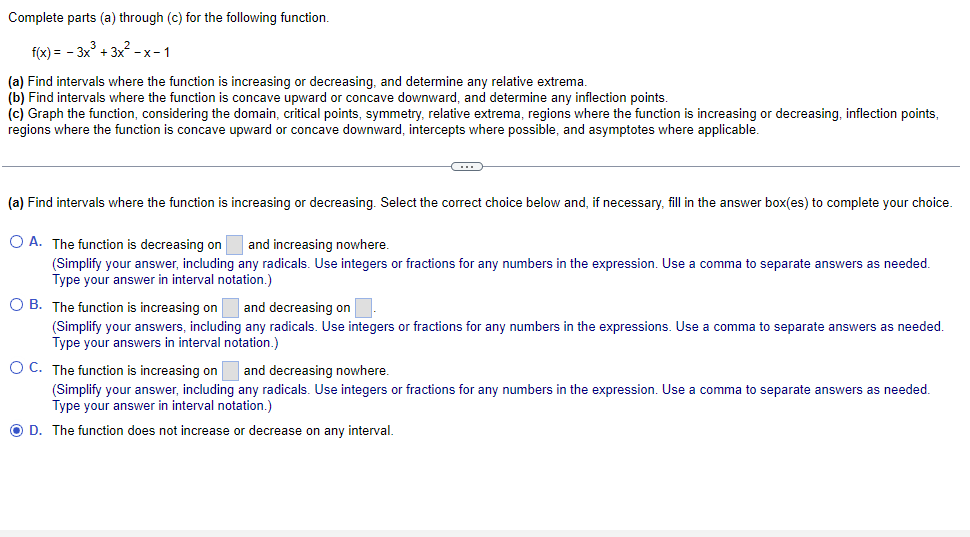Complete parts (a) through (c) for the following function. f(x) = - 3x + 3x -x-1 (a) Find intervals where the function is increasing or decreasing, and determine any relative extrema. (b) Find intervals where the function is concave upward or concave downward, and determine any inflection points. (c) Graph the function, considering the domain, critical points, symmetry, relative extrema, regions where the function is increasing or decreasing, inflection points, regions where the function concave upward or concave downward, intercepts where possible, and asymptotes where applicable. (a) Find intervals where the function is increasing or decreasing. Select the correct choice below and, if necessary, fill in the answer box(es) to complete your choice. O A. The function is decreasing on and increasing nowhere. (Simplify your answer, including any radicals. Use integers or fractions for any numbers in the expression. Use a comma to separate answers as needed. Type your answer in interval notation,) O B. The function is increasing on (Simplify your answers, including any radicals. Use integers or fractions for any numbers in the expressions. Use a comma to separate answers as needed. Type your answers in interval notation.) and decreasing on O C. The function is increasing on and decreasing nowhere. (Simplify your answer, including any radicals. Use integers or fractions for any numbers in the expression. Use a comma to separate answers as needed. Type your answer in interval notation.) O D. The function does not increase or decrease on any interval.
Complete parts (a) through (c) for the following function. f(x) = - 3x + 3x -x-1 (a) Find intervals where the function is increasing or decreasing, and determine any relative extrema. (b) Find intervals where the function is concave upward or concave downward, and determine any inflection points. (c) Graph the function, considering the domain, critical points, symmetry, relative extrema, regions where the function is increasing or decreasing, inflection points, regions where the function concave upward or concave downward, intercepts where possible, and asymptotes where applicable. (a) Find intervals where the function is increasing or decreasing. Select the correct choice below and, if necessary, fill in the answer box(es) to complete your choice. O A. The function is decreasing on and increasing nowhere. (Simplify your answer, including any radicals. Use integers or fractions for any numbers in the expression. Use a comma to separate answers as needed. Type your answer in interval notation,) O B. The function is increasing on (Simplify your answers, including any radicals. Use integers or fractions for any numbers in the expressions. Use a comma to separate answers as needed. Type your answers in interval notation.) and decreasing on O C. The function is increasing on and decreasing nowhere. (Simplify your answer, including any radicals. Use integers or fractions for any numbers in the expression. Use a comma to separate answers as needed. Type your answer in interval notation.) O D. The function does not increase or decrease on any interval.
Glencoe Algebra 1, Student Edition, 9780079039897, 0079039898, 2018
18th Edition
ISBN:9780079039897
Author:Carter
Publisher:Carter
Chapter1: Expressions And Functions
Section: Chapter Questions
Problem 74SGR
Related questions
Question

Transcribed Image Text:Complete parts (a) through (c) for the following function.
f(x) = - 3x + 3x -x-1
(a) Find intervals where the function is increasing or decreasing, and determine any relative extrema.
(b) Find intervals where the function is concave upward or concave downward, and determine any inflection points.
(c) Graph the function, considering the domain, critical points, symmetry, relative extrema, regions where the function is increasing or decreasing, inflection points,
regions where the function
concave upward or concave downward, intercepts where possible, and asymptotes where applicable.
(a) Find intervals where the function is increasing or decreasing. Select the correct choice below and, if necessary, fill in the answer box(es) to complete your choice.
O A. The function is decreasing on and increasing nowhere.
(Simplify your answer, including any radicals. Use integers or fractions for any numbers in the expression. Use a comma to separate answers as needed.
Type your answer in interval notation,)
O B. The function is increasing on
(Simplify your answers, including any radicals. Use integers or fractions for any numbers in the expressions. Use a comma to separate answers as needed.
Type your answers in interval notation.)
and decreasing on
O C. The function is increasing on
and decreasing nowhere.
(Simplify your answer, including any radicals. Use integers or fractions for any numbers in the expression. Use a comma to separate answers as needed.
Type your answer in interval notation.)
O D. The function does not increase or decrease on any interval.
Expert Solution
This question has been solved!
Explore an expertly crafted, step-by-step solution for a thorough understanding of key concepts.
This is a popular solution!
Trending now
This is a popular solution!
Step by step
Solved in 2 steps with 2 images

Recommended textbooks for you

Glencoe Algebra 1, Student Edition, 9780079039897…
Algebra
ISBN:
9780079039897
Author:
Carter
Publisher:
McGraw Hill


Algebra & Trigonometry with Analytic Geometry
Algebra
ISBN:
9781133382119
Author:
Swokowski
Publisher:
Cengage

Glencoe Algebra 1, Student Edition, 9780079039897…
Algebra
ISBN:
9780079039897
Author:
Carter
Publisher:
McGraw Hill


Algebra & Trigonometry with Analytic Geometry
Algebra
ISBN:
9781133382119
Author:
Swokowski
Publisher:
Cengage



Holt Mcdougal Larson Pre-algebra: Student Edition…
Algebra
ISBN:
9780547587776
Author:
HOLT MCDOUGAL
Publisher:
HOLT MCDOUGAL